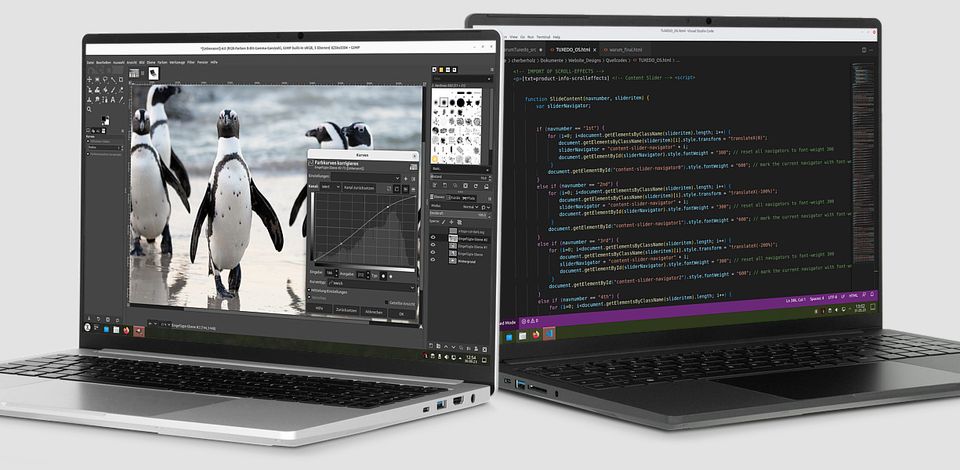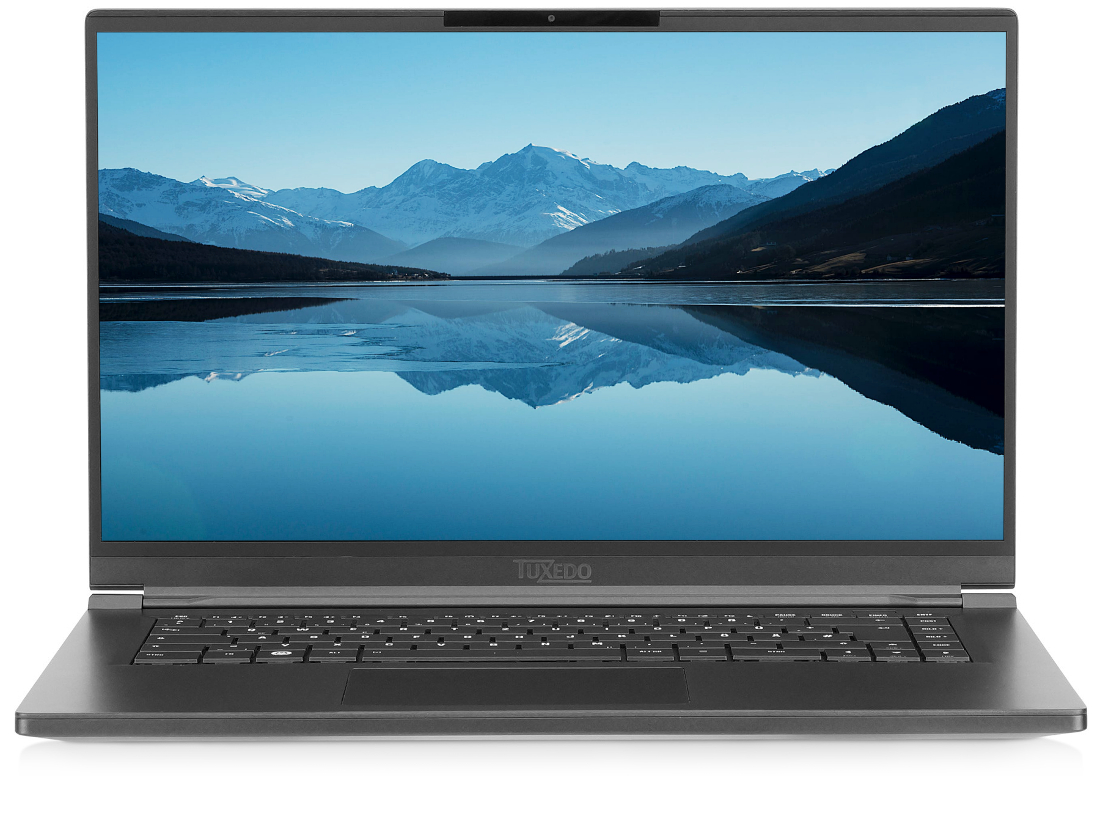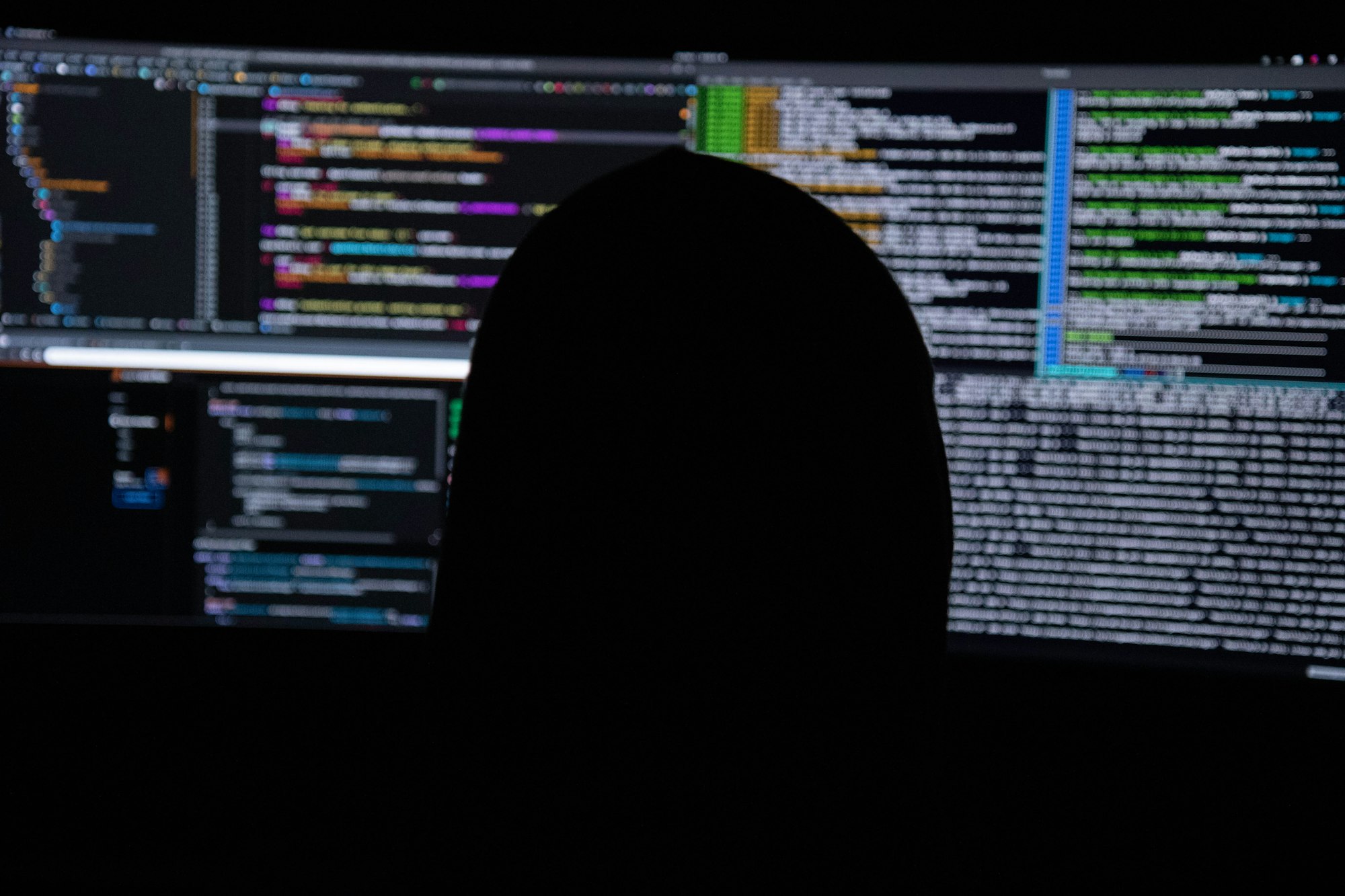A first look at the Tuxedo InfinityBook Pro 16 - Gen8

I was looking at a replacement for my MSI Stealth GS65 that served me well the last 5 years, when I heard, via The Linux Experiment, of Tuxedo, a German company based in Augsburg. They focuse on Linux laptops and in particular, they offer laptops with the Intel Management Engine deactivated! If you are as paranoid as I am, this might sound very tempting. And tempting it was since I finally decided to order the new version of their flagship, namely the InfinityBook Pro 16 - Gen8.

They offer up to a GeForce RTX 4070 in an magnesium casing for a total weight of 1.6kg. The elegant design reminds me of a crossover between a MacBook and a Dell XPS. It is possible to personalize the keyboard layout or the logo on the machine. Beyond the hardware, they offer to pre-configure the OS and eventually a virtual machine. They offer full encryption and propose several distributions, including their own, based on Ubuntu LTS called TuxedoOS.
As I still need to have a discrete NVidia GPU for work, I went for a GeForce RTX 4060. However, the goal with this laptop is to have enough autonomy to travel with it in a non-stationary setup, yet enough power to work properly. None of the other model would achieve this compromise as far as I understand.
Here is the full configuration that I ordered:
- NVIDIA GeForce RTX 4060 8GB | Silver casing
- Intel Core i7-13700H
- 64 GB (2x 32GB) DDR5 4800MHz Samsung
- without M.2 SSD
- without Wifi & Bluetooth
The reason why I chose without any SSD is because I was able to grab 2x TB Crucial P3 Plus PCIe 4.0 with a significant discount. However, it has to be noted that the price indicated on their website correspond roughly to retailer price which is a good point for the consumer.
I also decided to order without any Wifi & Bluetooth module because they do not offer Wifi 6E. Therefore, I preferred to ordered such Wifi card separately.
The downside is that I will not be able to provide a feedback on the services related to the OS installation but I will definitely be providing a feedback on the build and upgrade since I will have to open right way!
First, the service: I placed the order on a Sunday, on Monday the order was approved and on Friday the laptop was sent. Meanwhile, the order status was updated throughout the different stages of the production. No need to say that for a custom laptop build on order this is extremely fast! Note however that as I did not requested the installation of any OS, this might speed-up the order.
There is nothing special to say about the packaging: it is robust and does the job. Delivered without a scratch.
The chassis and connectivity
There is usually the Tuxedo logo on the top. For mine, I decided to go without any logo. The chassis feels sturdy. The weight is balanced and it is possible to open the laptop with one finger which is a good point of accessibility.

The only noticeable flex on the chassis is on the edge, between the screen and the bottom part. There is roughly half a millimeter such that a pressure on the screen part, right in the middle, will see it bent toward the bottom part. Nothing to worry about, but it is slightly more pronounced than on my MSI for instance.

The left side is equipped with
- a Kensington Slot,
- a USB-C 3.2 Gen2 that is connected to the NVidia and supports DisplayPort 1.4a and is compatible with G-SYNC. However, it does not support PowerDelivery DC-in such that it is not possible charge the laptop via this port. It supports DC-out up to 15W which is not really fast for modern smartphones, so it is mostly interesting for USB devices that can be powered via USB.
- a USB-A 3.2 Gen1,
- a SD card reader,
- a 2-in-1 audio jack (headphone + mic)

The right side is equipped with
- a Thunderbolt 4 that is connected to the integrated GPU and supports DisplayPort 1.4a and both way PowerDelivery: DC-in up to 100W as per TB4 norm and DC-out up to 15W.
- a USB-A 3.2 Gen1
- a HDMI 2.0b that is connected to the integrated GPU and supports HDCP 2.2.
- a Power plug (DC-In)
The fact that the TB4 and HDMI ports are connected to the iGPU instead of the dGPU is for me absolutely optimal and how it should be on any laptop. Indeed, my laptop is connected to a docking station with two additional screens over Thunderbolt. If the TB4 port was connected to the discrete GPU, it means that I would not be able to disable the discrete GPU while I am docked. However, I don't use the discrete GPU most of the time, only if I want to play or have to run an experiment to run on GPU. Therefore, having the discrete GPU running all the time would be a complete waste of energy, on top of inducing unnecessary heat. On the contrary, with the current wiring, even if I am docked and connected only to the integrated GPU, I am able to switch on the NVidia whenever I need it. Perfect!
The bottom part has a large mesh surface for the airflow. Although it is not visible during the usage, I find the screws particularly visible and ugly. Or maybe ugly because very visible?

Keyboard and trackpad
The keyboard is a full sized keyboard with a numpad! I think it is the first time I see a numpad on a laptop. In my case, having a numpad has no utility and makes it looks crowded. It also forces to adjust my right hand position. On the other hand, having the numpad adds some space between del/ins key and the power button which might be a blessing if, like me, you are prone to fat fingers.
Regarding the keyboard itself, it feels amazing and I immediately adjusted to the keycaps and activation force. I am no expert on keyboards so my words have little interest here, but it is rare that I can adapt that fast to a new keyboard. If I had to compain, I would say that the third function on some of the keys (e.g ~ or ! or @) is printed so small that at first I thought it was a defect on the keycap itself.
The trackpad is really large and reactive. It feels good although, as for the numpad, I rarely use it and don't have a serious point of comparison.

The biggest asset of this part of the chassis in my opinion is the extremely comfortable texture of the material around the keyboard. It is not slippery and soft as glass but rather a sort of velvet feeling that gives the proper grip while typing and prevent finger prints and sweat. Truly amazing.

Opening and upgrading
Opening the laptop is extremely easy: removing the 9 screws is enough for the lid to come easily without force. One small annoyance is the fact that there are two different screw lengths and as a result, one needs to remember carefully where are the longer ones to avoid any bad surprise when screwing them back. When screws cannot be the same length, the screws and corresponding threaded holes should have a color code somehow.
After removing the lid, we have a direct access to the motherboard and all components that are replaceable. This is a good thing, in particular in comparison to my MSI Stealth GS65 on which the motherboard is flipped! The build is extremely tight and clean. Note that the two connectors for the antenna have their endings protected in a small plastic tube and are then taped together.

The two M.2 slots are positioned on the opposite sides. The left one is positioned vertically and crosses the horizontal plan of the battery. If it was possible to find another position on the motherboard, it would probably free enough space to increase the battery capacity from 80Wh to something closer to the 99Wh limit allowed in an airplane.

Weight and mobility
Once everything has been installed, the Tuxedo InfinityBook Pro 16 - Gen8 weights, as promised, 1.6kg and 2.1kg with the entire stock power supply. Note that the power supply is rated 180W and is compact given the hardware in this laptop.


To improve the portability even more, I bought a Anker 737 GaNPrime 120W with 140W cable. It is quite pricey, but on the other hand, the weight of the charger with the cable is half of the stock one, i.e. 150g for a total of 1.85kg. Because a single port can output only 100W, keep in mind that it is not possible to fully use the NVidia GPU or at least, Tuxedo advises to disable it.


A word on the UEFI and software
The laptop shipped with a custom BIOS/UEFI with few interesting features:
- The possibility to deactivate Intel ME,
- Wake-on-Lan support
- The possibility to select a performance versus silence profile
- SecureBoot support
I am not able to give any feedback on TuxedoOS, a distro based on Ubuntu LTS as I installed myself a Ubuntu LTS. However, I've been able to install Tuxedo Control Center using their repository and the .deb package. TCC is a neat tool to monitor the hardware and manage the power profile, among other. Even on a vanilla Ubuntu, all the hardware components were properly recognized and manageable with the TCC. I would definitely recommend anyone using a Tuxedo laptop to use the Tuxedo Control Center.
More on the Tuxedo Control Center here:

If you are interested in installing Ubuntu with a RAID 1 and LVM, you might want to have a look at this article:

Conclusion
The Tuxedo InfinityBook Pro 16 - Gen8 is probably the best linux laptop available on the market at the moment I write these lines if you are looking for a good compromise between portability and performances. It has an impressive hardware and the build quality is really high. The customization options are also welcomed if it is something that you are looking for.
From my point of view, the price point is correct, especially given the size of the company and the quality of the laptop.
My only complaint would be the battery. I would have prefered a larger battery as the norm allows for 99Wh in airplanes, but I understand that it is rather hard to fit everything is such a small chassis.


Member discussion